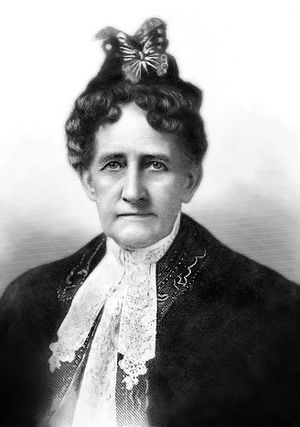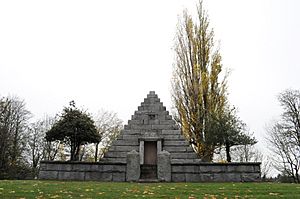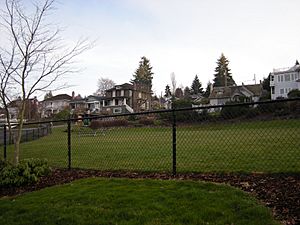Jane Rucker facts for kids
Quick facts for kids
Jane Morris Rucker
|
|
|---|---|
 |
|
| Born | January 29, 1830 Ohio, U.S.
|
| Died | November 10, 1907 (aged 77) Everett, Washington, U.S.
|
| Burial place | Evergreen Cemetery, Everett, Washington, U.S. |
| Monuments | Rucker Mausoleum |
| Organization | Woman's Book Club |
| Known for | A pioneer of Everett, Washington and the first female resident of the city. Mother, partner, and advisor of the Rucker Brothers, who are known as one of Everett's first landowners and vital developers of the city, its infrastructure and enterprises. |
| Children | 7, including
|
| Signature | |
Jane Morris Rucker (born January 29, 1830 – died November 10, 1907) was a very important pioneer in Everett, Washington. She was the first woman to live in Everett, arriving there in 1889. Jane Rucker and two of her sons, Wyatt and Bethel, owned a lot of land in the city. Wyatt and Bethel were known for their real estate work and were called the "Fathers of Everett." Jane was their partner and main advisor in all their plans.
The Ruckers were among the first people to own land and settle in the area that would become Everett. They moved to the Port Gardner Peninsula (now central Everett) in 1890. They bought a large amount of land and started planning the town of Port Gardner with other early settlers. Later, the Ruckers teamed up with famous people like John D. Rockefeller and Colgate Hoyt. The plans for Port Gardner were eventually combined into the City of Everett. The Rucker family owned about 50 acres (20 hectares) of downtown Everett. In 1891, they were the first to sell lots of land in the new city. In 1905, the family moved into the Rucker Mansion. This mansion was later surrounded by other big homes, forming the Rucker Hill neighborhood.
After Jane Rucker passed away, her sons built the Rucker Monument. This monument became the family mausoleum (a large tomb) in Everett's Evergreen Cemetery. It used to have a statue of Jane Rucker sitting on it.
Contents
Early Life and Family History
Jane Rucker was born in Ohio on January 29, 1830. Her parents were Moses and Sarah Morris. Her father, Moses, was a minister for over 50 years. Both her parents were pioneers in Ohio. In 1850, Jane married Wyatt Rucker, who was also the son of a minister. The Ruckers were members of the Baptist Church. They had seven children: four girls and three boys.
Wyatt Rucker died in Ohio on May 27, 1878, and was buried there. Later, on November 4, 1929, his remains were moved to the Rucker Mausoleum in Everett, Washington.
Pioneer Life in Everett
Arriving in the New City
In 1888, Jane Rucker and her two sons, Wyatt and Bethel Rucker, moved from Noble County, Ohio, to Tacoma, Washington.
In 1889, there was a lot of excitement. James J. Hill announced that the Great Northern Railway would cross the Cascade Mountains and reach the Puget Sound region. People hoped it would also come to the Port Gardner Peninsula. This area was formed by the Snohomish River and Port Gardner Bay. It later became a main part of the City of Everett. That same year, after reading about new chances in Snohomish County, the Ruckers moved to the peninsula. Jane Rucker became the first woman to live in Everett.
When the Ruckers arrived, the area was mostly forests. Only a few Coast Salish peoples lived there. There were no clear roads or stores. The main way to get supplies was by boat.
Helping Everett Grow
By 1890, the Rucker family bought about 1,000 acres (400 hectares) of land on the Port Gardner peninsula. This land later became downtown Everett. They were among the first non-Native American landowners in the city. They built their house there. They also started planning the townsite of Port Gardner. They worked with William G. Swalwell, his brother Wellington, and Frank B. Friday.
Their plans for Port Gardner changed when Henry Hewitt Jr. got involved. He was a lumberman from Tacoma. He wanted to build a much bigger industrial city. Hewitt invited John D. Rockefeller, Charles L. Colby, and Great Northern director Colgate Hoyt to invest. After getting funding, he convinced the Ruckers, Friday, and Swalwell to join his bigger plan. They agreed to work together. Each of them gave half of their land (about 800 acres or 320 hectares) to the East Coast investors. Even after giving away a lot of their property, the Ruckers still owned about 50 acres (20 hectares) of downtown Everett. They also planned the modern-day Rucker Hill neighborhood. In 1891, they were the first to sell the new lots of land in Everett. They made a good profit from this.
In November 1890, the town was renamed Everett. The Everett Land Company was formed. This company helped manage the fast growth of the area. The Rucker brothers helped start this company and ran it for several years.
Everett officially became a city in 1893. It had its own buildings and businesses. About 5,000 people lived there. However, tough economic times came after 1893. Many businesses struggled, and many people left the area. The city government almost ran out of money. Also, John Rockefeller started to take his investments out. The city began to recover in 1899. This was when James J. Hill and his Everett Improvement Company bought Rockefeller's holdings. The Rucker brothers played an active part in making this deal happen.
Jane Rucker was described as a "woman of exceptional ability" and "intelligent and independent." She was seen as a true partner and advisor in her sons' business dealings. Wyatt and Bethel Rucker are now recognized as the founding fathers of Everett.
The Ruckers also gave some of their land for early factories in Everett. They were involved in important city negotiations, like building a harbor. They owned the Monte Cristo Hotel and a nearby park. They were also involved with the Everett and Monte Cristo Railway and the Everett Terminal Company. They built a mountain resort called the Big Four Inn. They also had interests in banks, businesses, timber, and mining.
Later Life in Everett
In 1905, Jane Rucker, her two sons, and her daughter-in-law moved into the Rucker Mansion. This large home was on a hill overlooking Port Gardner Bay. The Ruckers attracted other wealthy families to the area. This area later became known as Rucker Hill. Their home became the center of a neighborhood with many fancy houses. These homes are now protected as a national historic district.
Personal Life and Death
Jane Rucker was a lifelong member of the Woman's Book Club.
She died on November 10, 1907, at the family mansion in Everett. She was survived by three of her sons – Wyatt J., Bethel J., William Rucker – and one of her daughters.
Historic Legacy
Rucker Mausoleum
After Jane Rucker's death, her sons built a pyramid-shaped monument with a tomb inside. This was in Evergreen Cemetery to honor their mother. It is thought to be the largest monument in the cemetery. It is also called "one of the grandest tombs in the country." At one time, a large statue of Jane Rucker sat above the doorway, but it was later removed. The words on the mausoleum door, dedicated by her sons, read: "The Pioneer of Everett, The True Wife, The Perfect Mother, The Soul of Honor."
This granite tomb is about 30 feet (9 meters) tall. It became a family mausoleum for more than 20 family members. It has a chapel area that is about 9 by 9 feet (2.7 by 2.7 meters). The mausoleum was valued at $30,000.
In 1994, parts of the movie Assassins were filmed at the tomb. Since it was built, the monument has sometimes been damaged by vandals. In 2008, the damage to the tomb and nearby graves was estimated at $12,000.
Other Family Landmarks
There are a few other places in Everett named after the Rucker family. These include Rucker Hill, Rucker Avenue, and the Rucker Mansion.
- The Rucker Mansion is about 13,000 square feet (1,200 square meters). Jane Rucker lived there during her last years, from 1905 to 1907. It is considered "the boldest, biggest mansion" among old Everett buildings. It is also called "the most beautiful site in the city." Building the mansion was valued at $40,000. The Rucker family owned the mansion until 1923. In 1974 or 1975, the mansion was added to the National Register of Historic Places.
- The Rucker Hill Historic District is a neighborhood of homes above Port Gardner Bay in Everett, Washington. It was added to the National Register of Historic Places in 1989.




